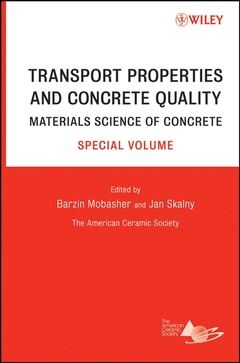Description
Transport Properties and Concrete Quality
Materials Science of Concrete, Special Volume
Materials Science of Concrete Series
Coordinators: Mobasher Barzin, Skalny Jan P.
Language: English
Keywords
experiments; percolation; porosity; cement; movement; observations; quantify; pastes; national; bentinstitutes; md; fume; reactivity; alkali; agglomerates; silica; ideker; civil; engineering; austin; university; texas; approach; mitigation
256 p. · 16.3x24.4 cm · Hardback
Description
/li>Contents
/li>Biography
/li>
During this meeting, scientific aspects of the relevant relationships between materials, mechanisms, processes, and service life were discussed.
* Provides a useful resource for understanding the most valuable aspects of cement-based materials, with topics ranging from the current state of practice, to theory, simulation, and testing and specifications.
* Logically organized and carefully selected articles give insight into the need to better integrate aspects of materials science, mechanics, modeling, and testing in developing tools of understanding the durability in cement-based materials.
Preface.
Mechanisms.
Ten Observations from Experiments to Quantify Water Movement and Porosity Percolation in Hydrating Cement Pastes.
— Dale P. Bentz National Institutes of Standards and Technology, Gaithersburg, MD
Alkali Silica Reactivity of Silica Fume Agglomerates.
— Maria C. Garci Juenger, Andrew J,. Maas, and Jason H. Ideker Department of Civil, Architectural and Environmental Engineering =. The University of Texas at Austin, Austin, TX, Thornton-Tomasetti Group, Dallas, TX
Mitigation of Alkali Silica Reaction: A Mechanical Approach.
— Maria G. Garci Juenger, Andrew J. Maas, and Jason H. Ideker Department of Civil, Architectural and Environmental Engineering. The University of Texas at Austin, Austin, TX, Thornton-Tomasetti Group, Dallas, TX
Experimental Studies and Parallel Computing on Coupled Moisture and Chloride Diffusion in Concrete.
— Yunping Xi, Ayman Ababneh, Lydia Abarr, A. Suwito, and Xiao-Chuan Cai University of Colorado, Boulder, CO, and Clarkson University, Potsdam, NY
Direct Phase-Resolved Strain Measurements in Cementations Materials.
— J.J Blemacki, S.E. Mikel, C. J. Parnham, R. Wang, J. Bai, T. Watkins, M.J. Lance and C. Hubbard, Tennessee Technological University, Georgia Institute of Technology, University of Tennessee and Oak Ridge National Laboratory
Modelling
Calcium Silicate Hydrate (C-S-H) Solid Solution Model Applied to Cement Degradation Using the Continuum Reactive Transport Model Flotran.
— J. W. Carey and P. C. Lichtner, Los Alamos National Laboratory, Los Alamos, New Mexico
Chemo-Physical and Mechanical Approach to Performance Assessment of Structural Concrete and Soil Foundation.
— Koichi Maekawa, Kenichiro Nakarai, and Tetsuya Ischida Department of Civil Engineering, University of Tokyo
Restraint and Cracking During Non-Uniform Drying of Cement Composites.
— John Bolander, Zhen Li, and Mien Yip, University of California, Davis, CA
A Simulation Model of the Packing Arrangements of Concrete Aggregates.
— Konstartin Sobolev and Adil Amirjanov, Universidad Autonoma de Nuevo Leon, San Nicolas, NL, Mexico, Department of Computer Engineering, Near East University, Nicosia, N. Cyprus
Modeling of Stiffness degradation and Expansion in Cement Based Materials Subjected to External Sulfate Attack.
B. Mobasher, Dept. of Civil and Environmental Eng, Arizona State University, Tempe, AZ
Testing
Measuring Permeability and Bulk Moduli Using the Dynamic Pressurization Technique
— Z.C. Grasley, D.A. Lange, G.W. Scherer, and J.J Valenza, Univ. of Illinois at U-Bana-Champaign, Urbana, IL, and Civil & Environmental Enginering, Princeton University, Princeton, NJ
Using Monte Carlo Analysis to Quantify How the Number and Arrangement of Sensors Influence the Accuracy of an In Situ Sensing System.
— Tom Schit and Jason Weiss, Purdue university, School of Civil Engineering, West, Lafayette, Indiana
Role of In situ Testing and Monitoring in Assessing the Durability of Reinforced Concrete.
— P.A. Muhammed Basheer, Kenneth V. Grattan, Tong Sun, W. John Mccarter, Adrian E. Long, Daniel McPlin, and Lulu Basheer
Influence of Production Method and Curing Conditions on Chloride Transport, Strength and Drying Shrinkage of Trernary Mix Concrete.
— Mateusz Radi8nkski, Jan Oiek, Anthony Zander, and Tommy Nantung Purdue University, School of Civil engineering; Indiana Dept. of Transportation, Indianapolis, IN
Appendix A. Workshop Program.
Appendix B. Workshop Sponsors.
Author Index.
Jan P. Skalny studied chemical engineering at Slovak Technical University (STU) in Bratislava and at the University for Chemical Technology (VSCHT) in Prague, where he graduated in 1958. He received his PhD (chemical/ceramic engineering) at the University of Mining & Metallurgy in Krakow (1965). In 1967 he left for the United Kingdom and in 1968 he settled with his family in the United States. After a short stay at the Clarkson University in upstate New York (1968-69), he focussed his career on industrial research management. He became Associate Director of Martin Marietta Laboratories and construction materials research director for W. R. Grace & Co. After early retirement in 1991, he became a consultant and is presently President of Materials Service Life, a high-tech consulting company specializing in service life prediction of concrete-based infrastructure.




